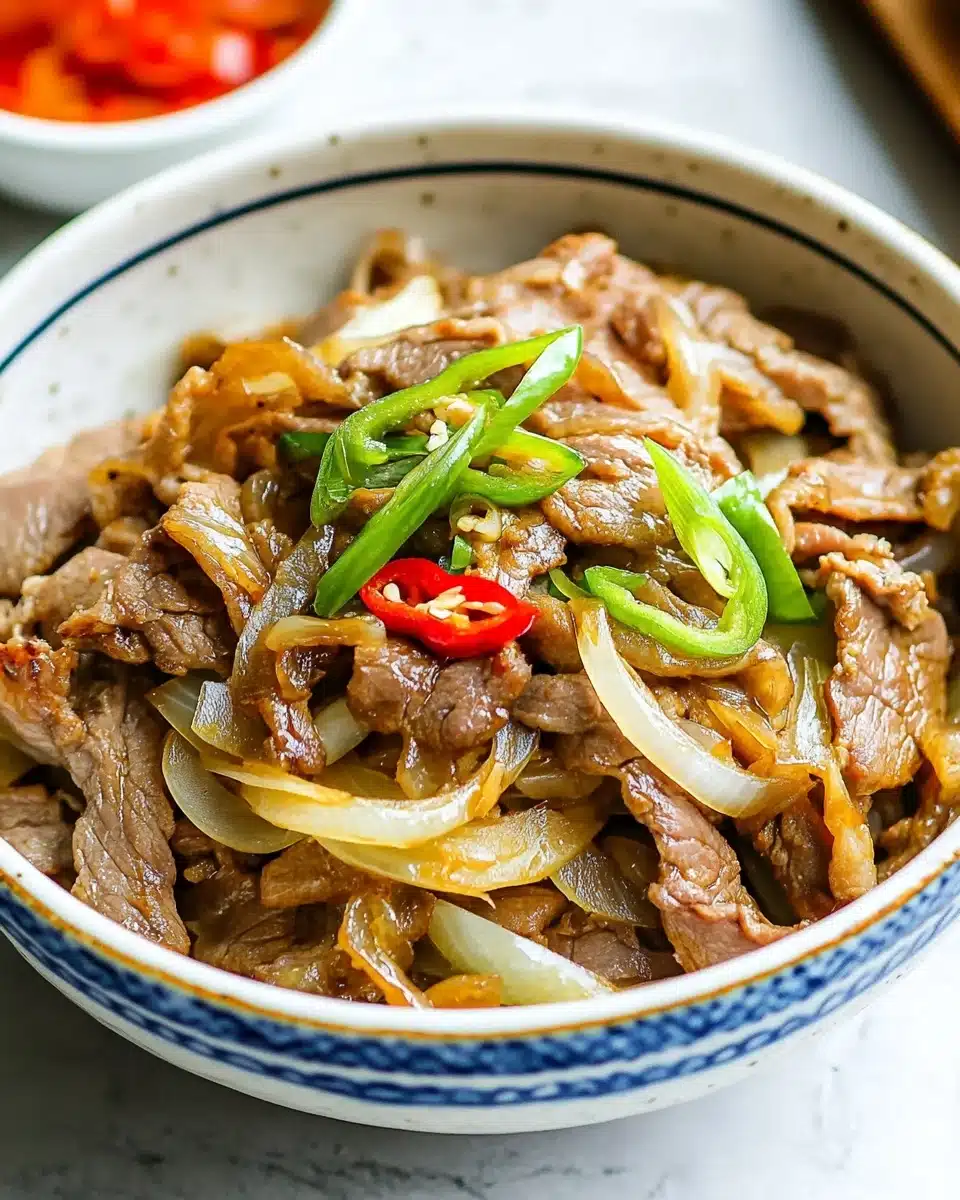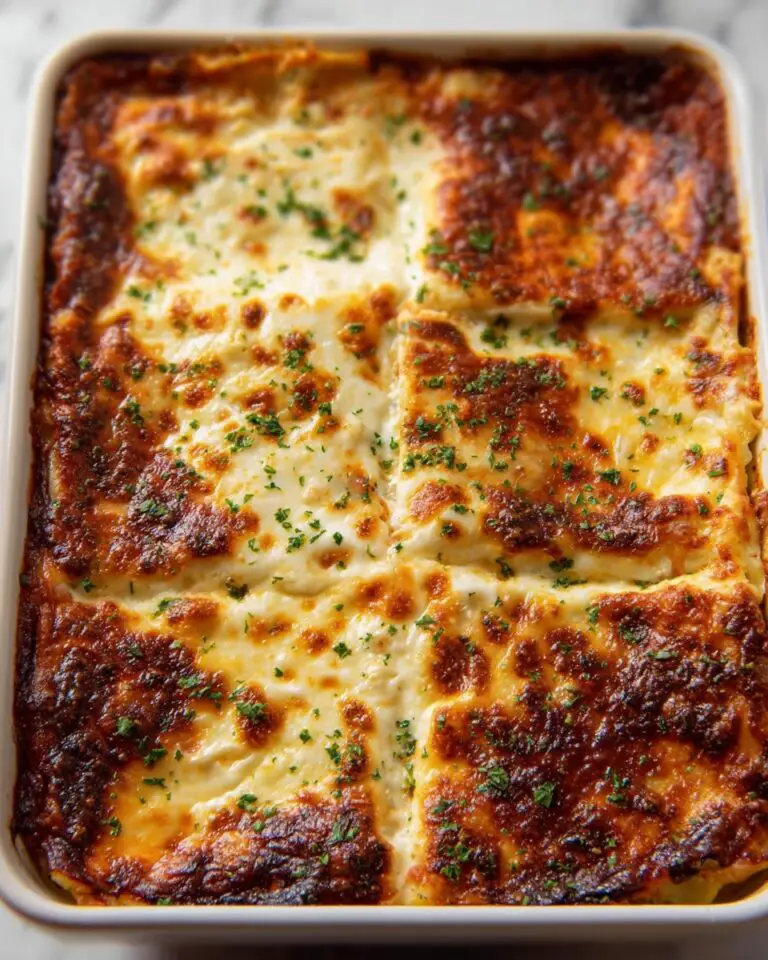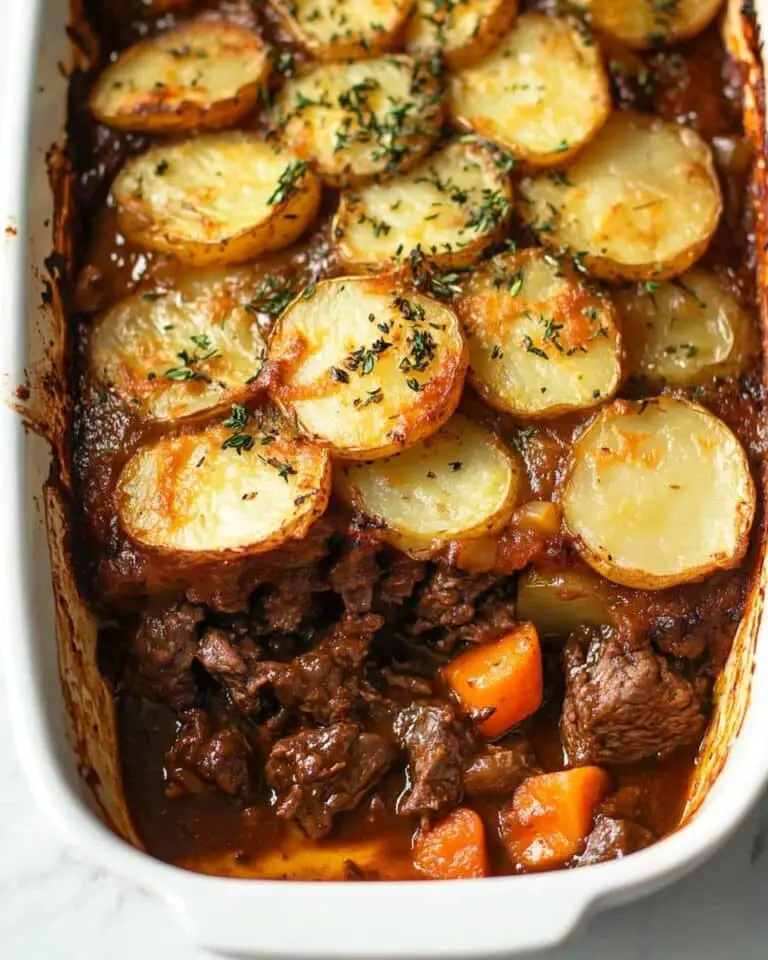If you’re looking for a cozy, comforting meal that’s bursting with flavor yet super simple to make, this Gyudon (Japanese Beef Rice Bowl) Recipe is absolutely the one to try. I love this dish because it captures that perfect sweet-savory balance with tender thinly sliced beef and onions simmered in a rich dashi-based broth, all spooned over fluffy steamed rice. It’s a classic Japanese favorite that works brilliantly for busy weeknights or whenever you want a quick taste of Japanese home cooking.
What makes this Gyudon (Japanese Beef Rice Bowl) Recipe truly special to me is just how accessible it is—once you know the few key steps, you’ll find it incredibly rewarding to get that deep umami flavor without needing any fancy ingredients or techniques. Plus, my family always goes crazy for it, and I know yours will too. I actually started making this when I wanted something filling that didn’t take forever and ended up loving the homemade version better than any takeout!
Why You’ll Love This Recipe
- Quick and Easy: You can have dinner on the table in about 20 minutes, perfect for busy evenings.
- Authentic Flavor: Using dashi and mirin gives you that genuine Japanese taste without fuss.
- Family Favorite: My loved ones always ask for this one again and again—it’s that comforting!
- Versatile Dish: Easily customizable with different toppings and sides to suit your mood and pantry.
Ingredients You’ll Need
The ingredients for this Gyudon come together beautifully to build layers of flavor. Fresh onions and thinly sliced beef are key, while the sauce combines a few essential Japanese staples that you can usually find at an Asian market or well-stocked grocery store.
- Onion: Adds sweetness and depth as it simmers; thin slices help it cook evenly.
- Green onion (scallion): Fresh, bright garnish that adds a nice bite and color contrast.
- Thinly sliced beef (ribeye or similar): The thinner, the better for tender, quick cooking—freezing slightly makes slicing easier.
- Dashi (Japanese soup stock): The backbone of the sauce; you can use powdered, bottled, or homemade for authentic umami.
- Sake: Adds a subtle sweetness and depth; can be swapped with dry sherry or rice wine.
- Mirin: Sweet rice wine that balances savory flavors; if unavailable, a mix of sake and sugar works well.
- Soy sauce: The salty, savory element—use good quality for clean flavor.
- Sugar: Helps round out the acidity and saltiness with mild sweetness.
- Cooked Japanese short-grain rice: The fluffy base that soaks up all the delicious sauce—don’t substitute with long grain!
- Pickled red ginger (beni shoga): Adds a tangy, spicy contrast and traditional finish.
Variations
I love how Gyudon invites personalization depending on what you have on hand or dietary preferences. Over time, I’ve played around with toppings and cooking methods to keep it fresh and exciting—feel free to make it your own.
- Add a Soft-Poached Egg: I sometimes top my Gyudon with a gently cooked egg which adds richness and creaminess that my family absolutely adores.
- Vegetarian Version: Swap out beef for thick slices of shiitake mushrooms and use vegan dashi for a satisfying plant-based take.
- Spicy Kick: Mixing in a touch of chili oil or pairing with spicy kimchi gives a delightful heat contrast.
- Kansai Style Gyudon: I also make a version where I stir-fry onions with oil first before adding the sauce—a little oiliness that’s nostalgic and hearty.
How to Make Gyudon (Japanese Beef Rice Bowl) Recipe
Step 1: Prep Your Ingredients
Start by thinly slicing half an onion—try to keep the slices even so they cook perfectly. Cut the green onion into thin diagonal slices and set those aside; they’ll add freshness at the end. For the beef, if it’s not pre-sliced, pop it in the freezer for about 10 minutes until it’s slightly firm—it makes slicing thin, uniform pieces way easier and safer.
Step 2: Make the Sauce and Layer It Up
In a large frying pan (don’t turn the heat on just yet!), combine ½ cup of dashi, 2 tablespoons sake, 2 tablespoons mirin, 3 tablespoons soy sauce, and 1 tablespoon sugar. Give it a good stir to dissolve all the sugar. Then spread your onion slices evenly in the pan so each layer gets flavorful broth.
Step 3: Add the Beef and Simmer
Place the beef slices on top of the onions, trying to separate them so they don’t clump together—this helps everything cook evenly. Cover the pan with a lid, turn the heat to medium, and bring it all to a gentle simmer. Once bubbling, lower the heat and let it cook covered for about 3 to 4 minutes.
Step 4: Skim and Finish with Green Onions
While it simmers, carefully lift the lid and skim off any scum or fat floating on top using a fine-mesh skimmer or spoon—this makes the broth clearer and less greasy. Then sprinkle in your green onions, cover back up, and cook just a minute more until everything’s tender and fragrant. If you want to get fancy, lightly beaten egg can be drizzled in here, cooking gently like a silky custard.
Step 5: Serve Over Steamed Rice
Scoop hot steamed Japanese short-grain rice into bowls (I like slightly generous servings so there’s room for all that luscious sauce). Ladle the beef and onions on top, drizzle some of the pan sauce over the rice, and finish with a few strips of pickled red ginger. The tangy ginger really cuts through the richness beautifully—trust me, don’t skip it!
Pro Tips for Making Gyudon (Japanese Beef Rice Bowl) Recipe
- Freeze the Meat Slightly: I always freeze the beef for about 10 minutes before slicing to get those perfect thin ribbons without tearing.
- Skim Often: Skimming impurities while simmering makes the broth clear, neat, and much tastier—I learned this the hard way after skipping it once!
- Use Good Dashi: The dashi gives the dish its signature depth; if you can, make your own or pick a high-quality instant powder.
- Don’t Overcook Beef: Keep an eye on the simmering time—a few minutes is enough to keep the beef tender and juicy rather than tough.
How to Serve Gyudon (Japanese Beef Rice Bowl) Recipe
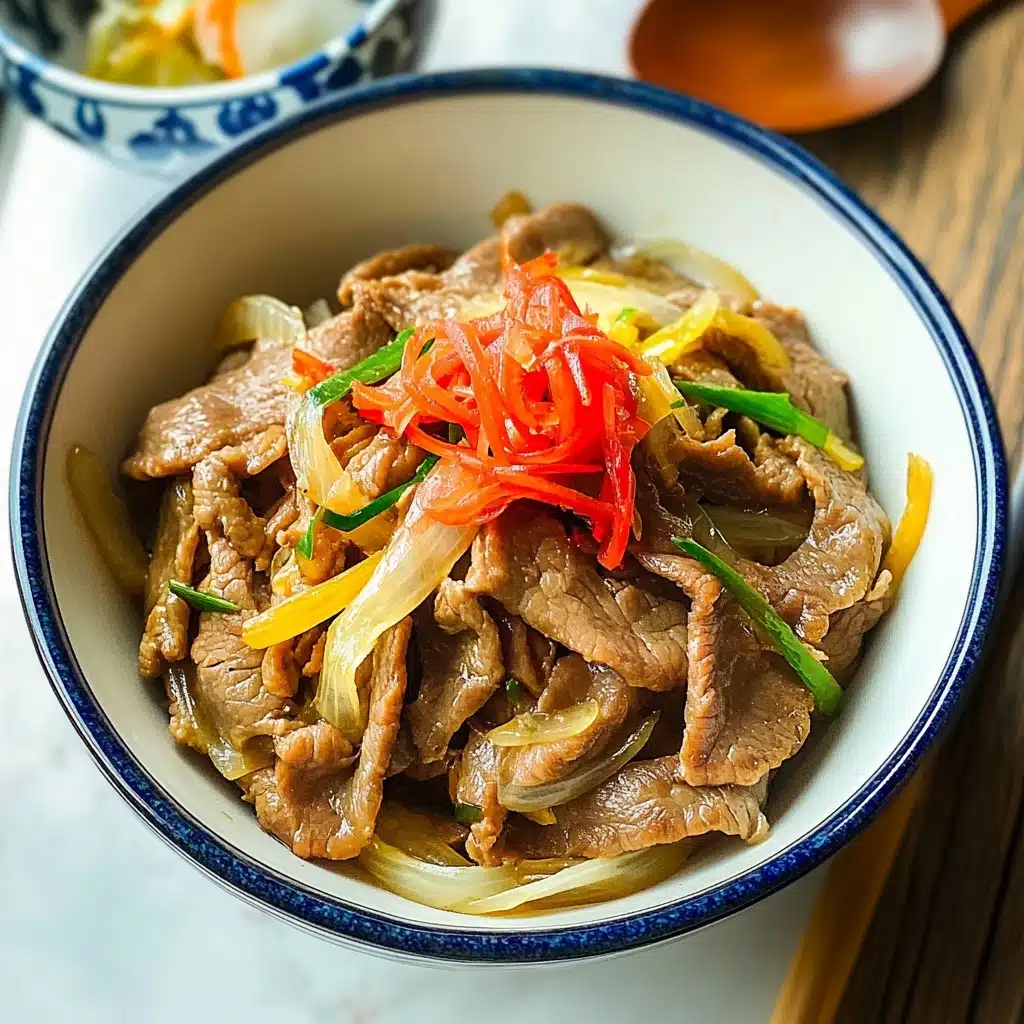
Garnishes
I love topping my Gyudon with pickled red ginger because it adds that classic tang and a pop of red color that makes the bowl inviting. Sometimes I scatter additional sliced green onions or even a soft-poached egg on top for creaminess. Toasted sesame seeds sprinkled on last-minute add a subtly nutty background note that’s surprisingly delightful.
Side Dishes
Gyudon is pretty hearty by itself, but I like pairing it with miso soup and a light cucumber salad or some steamed greens on the side to balance things out. A small bowl of pickled vegetables or kimchi also complements the flavor profile beautifully and adds texture contrast.
Creative Ways to Present
For special occasions, I sometimes serve Gyudon in pretty donburi bowls lined with a shiso leaf for an extra layer of herbal brightness. If inviting friends over, setting up a toppings bar with various garnishes let everyone build their perfect bowl. It’s a fun way to elevate a humble dish!
Make Ahead and Storage
Storing Leftovers
I keep leftover beef and onions in an airtight container in the fridge, and it stays good for about 2 to 3 days. Just make sure to cool it down quickly after cooking and reheat gently to avoid drying out the meat.
Freezing
Freezing Gyudon works surprisingly well! I portion it into freezer-safe containers and freeze for up to 3 or 4 weeks. When thawing, do it overnight in the fridge so the beef keeps its tender texture rather than getting tough.
Reheating
I gently reheat leftovers in a covered pan on low heat adding a splash of water or dashi to refresh the sauce, stirring occasionally. Avoid microwaving straight from frozen if you want to keep that great texture—the stovetop method is always my go-to.
FAQs
-
Can I use other cuts of beef for Gyudon?
Absolutely! While ribeye is ideal for its marbling and tenderness, you can also use sirloin or thinly sliced chuck. The key is slicing the meat very thinly so it cooks quickly and stays tender.
-
What if I don’t have dashi?
If you don’t have dashi, you can substitute with vegetable broth mixed with a bit of soy sauce and a pinch of seaweed powder if available. However, dashi really adds that authentic umami depth, so investing in some dashi powder or making your own is worth it.
-
How do I make this dish gluten-free?
Swap regular soy sauce for gluten-free tamari and ensure your dashi and mirin are gluten-free brands. The rest of the recipe is naturally gluten-free, so it’s easy to adapt.
-
Can I prepare Gyudon without alcohol?
Yes! Simply replace sake with water or a mix of water and a little rice vinegar, and use extra sugar to balance the flavors. The dish will still be delicious and rich.
-
Is it okay to leave out the pickled ginger garnish?
You can, but I highly recommend it! The pickled ginger adds a bright, tangy note that contrasts beautifully with the umami-rich beef. If you don’t have it, a small splash of rice vinegar or a squeeze of lemon helps brighten the bowl.
Final Thoughts
I absolutely love how this Gyudon (Japanese Beef Rice Bowl) Recipe brings together simple ingredients into something so satisfying and full of homey warmth. Whenever I make it, the aroma fills my kitchen and brings everyone running to the table, eager for that comforting taste. Trust me, once you try this recipe, you’ll want to keep it in your regular rotation—it’s just that good and versatile. So grab some thinly sliced beef and give it a go; I’m confident you’ll be hooked just like me!
Print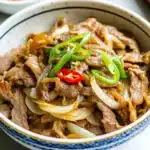
Gyudon (Japanese Beef Rice Bowl) Recipe
- Prep Time: 5 minutes
- Cook Time: 15 minutes
- Total Time: 20 minutes
- Yield: 2 servings
- Category: Main Course
- Method: Stovetop
- Cuisine: Japanese
Description
Gyudon, a classic Japanese beef rice bowl, features thinly sliced beef simmered with onions in a savory and slightly sweet dashi-based sauce. Served over steamed Japanese short-grain rice and garnished with pickled red ginger and sliced scallions, this quick and comforting dish is perfect for an easy weeknight dinner.
Ingredients
Main Ingredients
- 1/2 onion (4 oz, 113 g), thinly sliced
- 1 green onion/scallion, thinly sliced diagonally
- 1/2 lb thinly sliced beef (such as ribeye), cut into 3-inch wide pieces
Sauce
- 1/2 cup dashi (Japanese soup stock; Awase Dashi, dashi packet or powder, or Vegan Dashi)
- 2 Tbsp sake (or dry sherry, Chinese rice wine, or water for non-alcohol version)
- 2 Tbsp mirin (or 2 Tbsp sake/water + 2 tsp sugar)
- 3 Tbsp soy sauce
- 1 Tbsp sugar (adjust to taste)
For Serving
- 2 servings cooked Japanese short-grain rice (about 1 2/3 cups or 250 g per serving)
- Pickled red ginger (beni shoga or kizami beni shoga), garnish
Instructions
- Prepare Ingredients: Thinly slice ½ onion and cut 1 green onion/scallion diagonally into thin slices. Partially freeze the beef for 10 minutes, then cut into 3-inch wide pieces for easier handling.
- Make Sauce & Assemble: In a large frying pan (cold), combine ½ cup dashi, 2 Tbsp sake, 2 Tbsp mirin, 3 Tbsp soy sauce, and 1 Tbsp sugar. Stir to dissolve the sugar
- Add Onions: Spread the sliced onions evenly in the pan, separating the layers so they cook uniformly.
- Layer Beef: Arrange the thinly sliced beef over the onions, separating pieces to cover the surface evenly.
- Cook: Cover pan with a lid, turn heat to medium and bring to a simmer. Once simmering, reduce heat to low and cook, covered, for 3 to 4 minutes.
- Skim Broth: During cooking, lift the lid occasionally to skim off any scum and excess fat from the broth with a fine-mesh skimmer.
- Add Green Onions: Sprinkle the sliced green onions over the beef and cook covered for another minute. (Optional: add beaten eggs now for variation)
- Serve: Divide cooked rice into bowls, drizzle some pan sauce over the rice, then top with the beef and onion mixture. Add additional sauce and garnish with pickled red ginger.
- Store Leftovers: Refrigerate any leftover beef and sauce mixture in an airtight container for 2–3 days or freeze for up to 3–4 weeks.
Notes
- This recipe uses simmering as the primary cooking technique, which gently infuses the beef and onions with the flavorful sauce.
- An alternate Kansai-style gyudon involves stir-frying the onions and beef with oil instead of simmering, and optionally cooking eggs separately as a topping.
- Partially freezing the beef makes it easier to slice thinly and uniformly, improving texture and cooking consistency.
- Adjust sugar in the sauce according to your sweetness preference; mirin already contains some sugar.
- Use pickled red ginger generously as a bright and tangy contrast to the savory beef.
- Japanese short-grain rice is ideal for authenticity but medium-grain rice can be substituted if unavailable.

